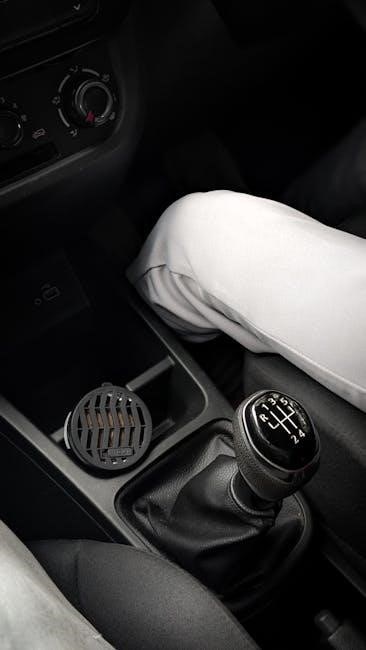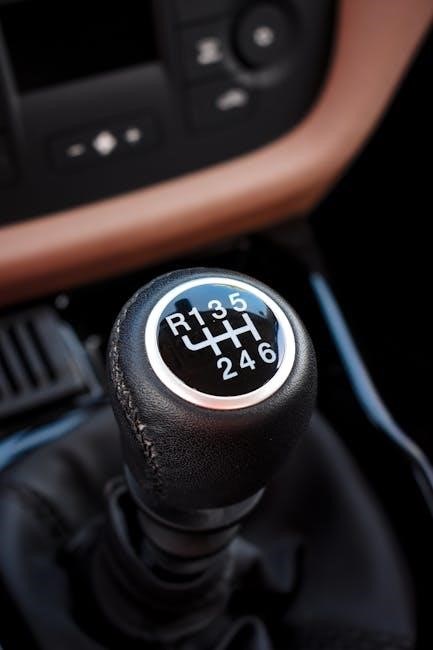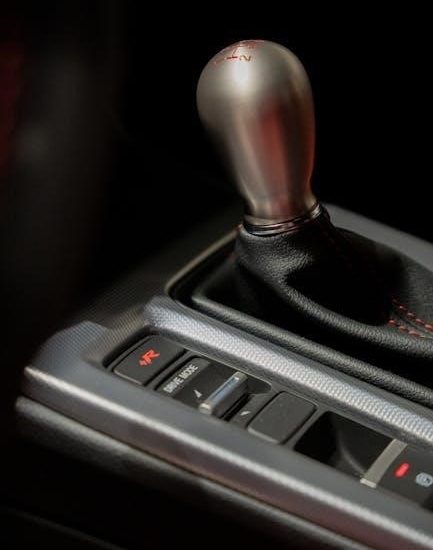The Dodge Charger manual transmission offers drivers enhanced control and engagement‚ making it a favorite among enthusiasts. It provides better fuel efficiency and a direct connection to the vehicle‚ ensuring a more immersive driving experience. With a rich history in performance cars‚ the manual transmission remains a timeless choice for those who value precision and power.
1.1 Overview of the Dodge Charger Manual Transmission
The Dodge Charger manual transmission is a driver-focused system designed for precision and performance. It allows for enhanced control over shifting gears‚ creating a more engaging driving experience. Known for its responsiveness‚ the manual transmission connects the driver directly to the vehicle‚ offering better fuel efficiency and a sporty feel. Historically‚ manual transmissions have been a staple in performance cars‚ and the Charger continues this tradition‚ catering to enthusiasts who value a hands-on driving experience.
1.2 Importance of Manual Transmissions in Performance Cars
Manual transmissions are integral to performance cars like the Dodge Charger‚ offering unparalleled driver engagement and control. They allow precise gear shifts‚ optimizing acceleration and responsiveness‚ which are critical for high-performance driving. Unlike automatics‚ manuals provide a direct connection between the driver and the car‚ enhancing the overall driving experience. This tactile control makes manual transmissions a preferred choice among driving enthusiasts‚ ensuring a more immersive and dynamic ride.
1.3 Brief History of Manual Transmissions in Dodge Charger Models
Manual transmissions have been a cornerstone of the Dodge Charger’s identity since its debut in the 1960s; Early models featured three- and four-speed manuals‚ catering to performance enthusiasts. The 1970s saw the rise of the iconic four-speed manual paired with the 426 Hemi V8. By the 1980s‚ automatics gained popularity‚ but manuals remained an option for purists. In the 2000s‚ Dodge reintroduced modern six-speed manuals‚ blending heritage with contemporary performance. This legacy continues‚ making manual transmissions a defining feature of the Charger’s storied history.

Benefits of a Manual Transmission in the Dodge Charger
A manual transmission in the Dodge Charger enhances driver engagement‚ offering precise control and a direct connection to the vehicle. It improves fuel efficiency and reduces costs compared to automatic transmissions‚ making it a practical and performance-focused choice for enthusiasts.
2.1 Enhanced Driver Control and Engagement
The manual transmission in the Dodge Charger provides drivers with enhanced control and engagement‚ allowing for precise gear shifts and a more direct connection to the vehicle. This setup enables better handling and responsiveness‚ making it ideal for performance-oriented driving. The physical interaction with the clutch and gear stick creates a more immersive experience‚ giving drivers a greater sense of command over the car’s acceleration and deceleration.
2.2 Improved Fuel Efficiency
The manual transmission in the Dodge Charger often delivers better fuel efficiency compared to automatic transmissions‚ especially when driven skillfully. By allowing drivers to control gear shifts manually‚ the system minimizes unnecessary energy loss‚ optimizing power delivery. This mechanical advantage results in improved mileage‚ particularly in city driving conditions. While actual efficiency depends on driving habits‚ the manual transmission’s direct connection to the engine ensures resourceful fuel use‚ making it a practical choice for performance and economy.
2.3 Cost-Effectiveness Compared to Automatic Transmissions
Manual transmissions in the Dodge Charger are generally more cost-effective than automatics‚ offering lower purchase prices and reduced maintenance costs. With fewer components and no complex electronics‚ manual transmissions are less expensive to repair and replace. Additionally‚ their simplicity often results in lower long-term ownership costs. While fuel efficiency varies based on driving habits‚ manuals typically provide better mileage in city driving‚ further saving money. This makes the Charger’s manual transmission a practical choice for budget-conscious drivers seeking both performance and economy.

Components of a Manual Transmission System
The Charger’s manual transmission system includes a clutch pedal‚ gear stick‚ flywheel‚ and pressure plate‚ working together to enable precise gear shifts and smooth power delivery to the wheels.
3.1 Clutch Pedal and Its Function
The clutch pedal is a critical component in the Charger’s manual transmission system. Its primary function is to disengage the engine from the transmission‚ allowing smooth gear shifts. When pressed‚ it releases the clutch disc from the flywheel‚ enabling the driver to change gears without grinding. Proper use of the clutch pedal is essential for maintaining the longevity of the transmission and ensuring seamless acceleration. In the Charger‚ the clutch pedal is designed for precise control‚ offering a responsive and engaging driving experience.

3.2 Gear Stick and Shift Mechanism
The gear stick‚ or shift lever‚ is the manual interface for selecting gears in the Charger’s transmission. Connected to the shift mechanism‚ it translates the driver’s input into precise gear changes. The mechanism ensures smooth engagement of gears through synchronized components. The driver operates the gear stick to move through the gear sequence‚ with a clutch pedal disengaging the engine during shifts. This system provides tactile feedback‚ allowing drivers to feel each gear transition. The shift mechanism is designed for durability and responsiveness‚ making it a key part of the Charger’s manual transmission experience.
3.3 Role of the Flywheel and Pressure Plate
The flywheel and pressure plate are critical components in the Charger’s manual transmission system. The flywheel is mounted to the engine’s crankshaft‚ storing rotational energy to smooth engine operation during gear shifts. The pressure plate‚ activated by the clutch pedal‚ engages or disengages the clutch disc from the flywheel. Together‚ they facilitate smooth power transfer between the engine and transmission‚ enabling seamless gear changes. Proper alignment and maintenance of these components are essential for optimal clutch performance and longevity.

Performance and Acceleration with a Manual Transmission
Manual transmissions enhance the Charger’s acceleration and responsiveness‚ offering precise control over gear shifts for a more engaging and dynamic driving experience.
4.1 How Manual Transmissions Improve Acceleration
Manual transmissions in the Charger enhance acceleration by allowing drivers to precisely control gear shifts‚ eliminating delays caused by automatic transmissions. This direct connection enables quick shifts‚ maintaining optimal RPM levels for maximum power delivery. The driver’s ability to anticipate and execute shifts ensures smoother‚ faster acceleration‚ making manual transmissions a preferred choice for performance-driven enthusiasts seeking instant responsiveness and control.
4.2 Impact of Manual Shifts on Handling and Responsiveness
Manual shifts in the Charger significantly enhance handling and responsiveness by allowing drivers to maintain optimal gear engagement during cornering or dynamic driving. The direct mechanical connection provides immediate feedback‚ enabling precise control over acceleration and deceleration. This driver engagement fosters a more intuitive relationship with the vehicle‚ particularly during high-performance maneuvers. The ability to manually select the right gear ensures responsiveness aligns with driving conditions‚ making the Charger more agile and enjoyable to handle on both straight roads and winding paths.
4.3 Comparison with Automatic Transmission Models
Manual transmissions in the Charger offer distinct advantages over automatic models‚ particularly in driver engagement and fuel efficiency. While automatics provide convenience and smooth shifting‚ manuals deliver a more direct driving experience. The manual’s ability to hold gears during acceleration enhances responsiveness‚ especially in performance driving scenarios. However‚ automatic transmissions‚ such as the Charger’s eight-speed‚ excel in urban driving and ease of use. The choice between the two ultimately depends on the driver’s preference for control versus convenience‚ each catering to different driving styles and priorities.

Maintenance and Troubleshooting for Manual Transmissions
Regular maintenance‚ such as clutch replacement and transmission fluid changes‚ ensures optimal performance. Common issues include worn synchros and gear grinding‚ often resolved with adjustments or repairs.
5.1 Common Issues in Manual Transmissions
Common issues in manual transmissions include clutch wear‚ gear grinding‚ and fluid leaks. Clutch wear can cause slipping or hesitation‚ while gear grinding often results from improper shifting. Fluid leaks may lead to premature wear of components. Additionally‚ synchronization issues and bearing noise can arise from heavy use or lack of maintenance. Identifying these problems early ensures timely repairs and prevents further damage. Regular checks and prompt action are crucial for maintaining smooth operation and extending the transmission’s lifespan.
5.2 Tips for Extending the Lifespan of the Clutch and Gears
To extend the lifespan of the clutch and gears‚ avoid aggressive driving and ensure smooth shifts. Regularly check and top off transmission fluid levels‚ as low fluid can lead to component wear. Replace the clutch when showing signs of wear‚ and use quality components. Avoid riding the clutch‚ as this can cause unnecessary strain. Inspect gears for wear and address any issues promptly. Proper maintenance and driving habits significantly prolong the durability of the manual transmission system in your Charger.
5.3 DIY Repair and Maintenance Guide
Regularly inspect and replace worn components like clutch pads and gear synchronizers. Check transmission fluid levels and top off as needed to prevent wear. Use a factory service manual for guidance on complex repairs. Replace gaskets and seals during major overhauls to ensure leak-free operation. Avoid aggressive driving to reduce stress on the system. Clean and lubricate gears during servicing to maintain smooth shifting. Always use quality replacement parts to ensure durability. Proper DIY maintenance can significantly extend the lifespan of your Charger’s manual transmission.

Buyer’s Guide for Dodge Charger Manual Transmission Models
When purchasing a Dodge Charger with a manual transmission‚ prioritize models with precise shifting and enhanced driver engagement. Consider recent years with updated gearboxes for smoother performance and better fuel efficiency. Ensure the vehicle’s maintenance history is clean‚ and opt for a test drive to assess clutch and gear performance.
6.1 Factors to Consider When Choosing a Manual Transmission
When selecting a manual transmission for your Dodge Charger‚ consider performance‚ fuel efficiency‚ and cost-effectiveness. Prioritize models with smooth shifting and responsive acceleration. Check the transmission’s compatibility with your engine and driving style. Reliability and durability are crucial for long-term satisfaction. Additionally‚ evaluate maintenance costs and the availability of parts. Test drive the vehicle to assess clutch feel and gear engagement. Finally‚ consider the vehicle’s intended use—whether for daily driving or performance purposes—to ensure the manual transmission meets your needs effectively.
6.2 Key Features to Look for in a Charger with Manual Transmission
When evaluating a Charger with a manual transmission‚ focus on smooth shifting‚ responsive acceleration‚ and precise clutch engagement. Ensure compatibility with your engine and drivetrain. Opt for models offering performance upgrades and robust power output. Consider fuel efficiency ratings‚ as manuals often excel in this area. Additionally‚ research the vehicle’s reputation for reliability and durability; Prioritize models with a proven track record for manual transmissions‚ ensuring a satisfying and performance-oriented driving experience.
6.3 Model Years with the Best Manual Transmission Options
Enthusiasts often highlight the 2015 Charger for its smooth manual shifting and responsive acceleration. The 2016 Charger R/T is praised for its compatibility with performance upgrades. Meanwhile‚ the 2021 Charger Hellcat stands out for its precision and power delivery. Earlier models‚ such as the 2012 Charger‚ also offer robust manual transmission options. Each of these model years provides a unique blend of performance and driver engagement‚ making them top choices for those seeking a manual transmission Charger.

The Future of Manual Transmissions in the Dodge Charger
The future of manual transmissions in the Dodge Charger remains uncertain‚ with automatic and dual-clutch options gaining prominence. However‚ enthusiast demand ensures manuals remain relevant.
7.1 Trends in Manual Transmission Availability
Manual transmissions in the Dodge Charger are becoming less common as automatic and dual-clutch options gain popularity. Despite this‚ enthusiasts continue to advocate for manual transmissions‚ ensuring their availability in select models. The demand for driver engagement and control keeps manual transmissions relevant‚ even as technology advances. However‚ their availability may diminish in future models‚ making them a niche option for performance-driven buyers.
7.2 Impact of Automatic and Dual-Clutch Transmissions
Automatic and dual-clutch transmissions have significantly influenced the role of manual transmissions in the Dodge Charger. These systems offer improved acceleration‚ smoother shifting‚ and better fuel efficiency‚ making manual transmissions less necessary for everyday driving. Dual-clutch transmissions‚ in particular‚ combine the efficiency of manuals with the convenience of automatics‚ further reducing the demand for traditional manual options. Despite this‚ manual transmissions remain popular among driving enthusiasts who value the tactile connection and control they provide.
7.3 Enthusiast Demand for Manual Transmissions
Despite advancements in automatic and dual-clutch transmissions‚ manual transmissions remain in high demand among driving enthusiasts. The tactile connection and control offered by manual shifting create a more immersive and engaging driving experience. Enthusiasts often prioritize the thrill of precise gear changes and the ability to optimize performance. This dedication has fostered a strong community of manual transmission supporters‚ with many seeking out Charger models specifically for their manual options. The demand reflects a passion for driving purity and the heritage of performance vehicles.

Community and Forums for Charger Manual Transmission Owners
Active communities and forums dedicated to Charger manual transmission owners provide a platform for sharing knowledge‚ modifications‚ and troubleshooting. These spaces foster camaraderie and support among enthusiasts.
8.1 Popular Online Communities for Manual Transmission Enthusiasts
Popular online communities like Mopar Insiders and Dodge Charger forums are hubs for manual transmission enthusiasts. These platforms offer valuable resources‚ from troubleshooting tips to modification ideas. Members share experiences‚ discuss performance upgrades‚ and provide support for maintenance and repairs. Enthusiasts can connect with like-minded drivers‚ fostering a sense of camaraderie and shared passion for manual transmissions. These communities are essential for staying informed and inspired about the Charger’s manual transmission.
8.2 Resources for Modifications and Upgrades
Enthusiasts seeking to modify or upgrade their Charger’s manual transmission can explore various resources. Forums like Mopar Insiders and specialized websites offer DIY guides‚ aftermarket part recommendations‚ and expert advice. Technical guides and courses provide in-depth knowledge for advanced modifications. These resources help owners enhance performance‚ improve shifting precision‚ and maintain their transmission’s longevity. Whether upgrading the clutch or refining the gear stick‚ these tools empower enthusiasts to customize their Charger’s manual transmission for optimal driving experience.
8.3 Events and Meetups for Manual Transmission Owners
Manual transmission enthusiasts often gather at car shows‚ track days‚ and specialized meetups to celebrate their passion. These events provide a platform for Charger owners to share knowledge‚ showcase modifications‚ and connect with like-minded drivers. Many communities organize regional meets‚ while larger events like car festivals attract a broader audience. These gatherings not only foster camaraderie but also offer opportunities to learn about maintenance‚ performance tuning‚ and the latest upgrades. They are a great way to immerse oneself in the culture of manual transmission ownership and enhance driving skills.

Customization and Upgrades for Manual Transmissions
Customizing the Charger’s manual transmission enhances performance and driving experience. Upgrades include high-performance clutches‚ lightweight flywheels‚ and precision-engineered gear sets. Aftermarket shift kits improve responsiveness‚ while transmission tuning optimizes acceleration for racing or track use‚ ensuring maximum power delivery and driver satisfaction.
9.1 Performance Upgrades for the Clutch and Gears
Upgrading the clutch and gears in a Charger manual transmission enhances performance and durability. High-performance clutches offer improved grip and faster engagement‚ reducing slip during aggressive driving. Lightweight flywheels reduce inertia‚ allowing for quicker rev changes and smoother shifts. Precision-engineered gear sets with shorter ratios can improve acceleration and responsiveness‚ especially in racing or track environments. These upgrades not only boost performance but also provide a more direct and engaging driving experience‚ making them a popular choice for enthusiasts seeking to maximize their car’s potential.
- High-performance clutches for better grip and faster engagement.
- Lightweight flywheels for reduced inertia and smoother shifts.
- Precision-engineered gear sets for improved acceleration.
Consulting experts ensures these upgrades are tailored to your driving needs and vehicle specifications.
9.2 Aftermarket Modifications for Enhanced Shifting
Aftermarket modifications can significantly enhance the shifting experience in a Charger manual transmission. Upgrading to a short-throw shifter reduces shift distance‚ enabling quicker and more precise gear changes. Lightweight components‚ such as aluminum gearsticks‚ further improve shifting responsiveness. Additionally‚ aftermarket bushings and mounts can tighten the shift mechanism‚ reducing play and delivering a more direct feel. These modifications are popular among enthusiasts seeking to optimize their car’s performance and driving dynamics for both daily driving and track use.
- Short-throw shifters for faster gear changes.
- Lightweight aluminum gearsticks for improved responsiveness.
- Aftermarket bushings and mounts for a tighter shift feel.
These upgrades collectively enhance the overall shifting experience‚ making it more engaging and precise.
9.3 Tuning the Transmission for Racing or Track Use
Tuning the Charger manual transmission for racing or track use involves optimizing gear ratios and clutch performance for maximum acceleration and handling. High-performance clutch kits with increased clamp force ensure smoother power delivery during aggressive shifts. Lightweight components like aluminum flywheels reduce inertia‚ enhancing responsiveness. Synthetic transmission lubricants maintain performance under extreme heat. These modifications‚ when installed by professionals‚ allow drivers to exploit the Charger’s full potential on the track‚ delivering unparalleled acceleration and precision.
- Performance clutch kits for improved power delivery.
- Lightweight components like aluminum flywheels.
- High-performance lubricants for optimal operation.
The Dodge Charger manual transmission embodies precision‚ power‚ and driver engagement‚ offering a timeless driving experience. Its relevance endures‚ appealing to enthusiasts who crave control and performance.
10.1 Final Thoughts on the Charger Manual Transmission
The Dodge Charger manual transmission delivers a driving experience that combines precision‚ power‚ and engagement. Enthusiasts praise its ability to connect the driver with the road‚ enhancing control and satisfaction. While modern automatics dominate‚ the manual remains a cherished option‚ offering a unique blend of performance and tradition. As automotive trends evolve‚ the Charger’s manual transmission stands as a testament to driving purism‚ ensuring its legacy endures among car enthusiasts.
10.2 Why Manual Transmissions Remain Relevant in Modern Cars
Manual transmissions remain relevant due to their unique driving engagement and cost-effectiveness. They offer better fuel efficiency when driven skillfully and provide a direct connection to the vehicle‚ appealing to enthusiasts. Despite advancements in automatics‚ manuals are prized for their simplicity‚ lower maintenance costs‚ and racing heritage. They cater to purists who value driver involvement and precision‚ ensuring their place in modern automotive culture alongside evolving transmission technologies.





